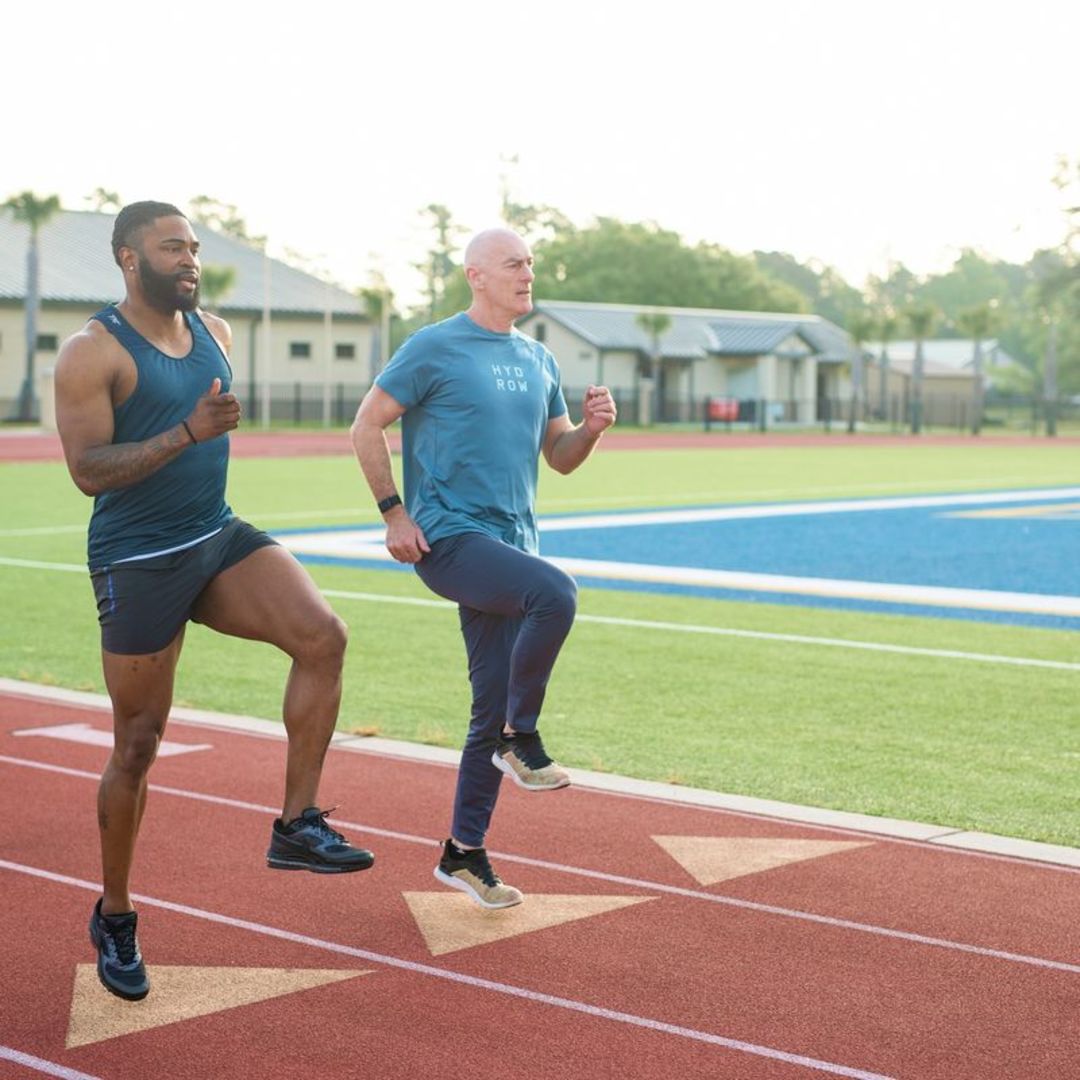What Is Resistance Training?

If you’re looking for a new type of exercise to add to your fitness routine, you’ve likely heard of resistance training. However, what exactly is resistance training, and why is it worth your time?
In this blog, we’ll explore:
Let’s dive in!
What is resistance training?
Resistance training—also known as strength training or weight training—involves exercises where muscles work against an external force, such as weights, resistance bands, weight machines, or body weight, to build strength, endurance, and muscle mass.
What are the benefits of resistance training?
Resistance training plays a crucial role in maintaining overall health, fitness, and quality of life. When you begin strength or resistance training, you’ll quickly notice an increase in energy, and your mood will improve from the release of endorphins. That’s on top of feeling stronger and more capable in your daily life.
Here are some of the extraordinary benefits from engaging in resistance training:
1. Builds and maintains muscle strength
Strong muscles support everyday activities, from lifting groceries to maintaining proper posture. As we age, muscle mass naturally decreases, so resistance training helps preserve strength and function.
2. Boosts metabolism
Building muscle increases your resting metabolic rate, helping you burn more calories throughout the day and support weight management goals.
3. Improves bone health
Resistance training puts stress on bones, stimulating bone growth and reducing the risk of osteoporosis or fractures, especially important as we age.
4. Enhances mobility and balance
Strong muscles improve balance and coordination, reducing the risk of falls or injuries while helping you move with ease.
5. Supports joint health
Strengthening muscles around the joints stabilizes and protects them from wear and tear, preventing joint pain and improving overall movement.

Cardio and strength, combined
Burn calories and build muscle with steady, natural movements.
6. Boosts mental health and confidence
Regular strength training releases endorphins, which improve mood and reduce stress. Achieving fitness goals can boost confidence and mental well-being.
7. Enhances athletic performance
If you're involved in sports or physical activities, cross-training with resistance training improves strength, endurance, and overall performance, reducing your risk of injury.
8. Slows the aging process
Resistance training helps counter the effects of aging, such as muscle loss, decreased bone density, and reduced mobility, keeping you healthier and more independent.
Incorporating resistance training into your routine two to three times a week can provide these long-term benefits, regardless of age or fitness level. You don’t have to lift for an hour five times per week—in fact, you can see and experience improvements in your strength in as little as 2o minutes twice a week.
The key principles of resistance training
The key principles of resistance training guide the development of effective and safe workouts that lead to improved strength, muscle mass, and fitness. These principles include:
Progressive overload
Specificity
Variation
Rest and recovery
Volume
Intensity
Time under tension (TUT)
Individualization
Consistency
Overload and adaptation
1. Progressive overload
Progressive overload is a strength training technique that involves gradually increasing the difficulty of your workouts over time. The goal is to maximize your strength gains and muscle mass by regularly challenging the body. Increasing the resistance, intensity, or volume of training over time will continually challenge your muscles to adapt and grow stronger, preventing plateaus.
2. Specificity
Resistance training entails tailoring your exercises to target specific muscles or fitness goals. Training should focus on the areas you want to improve, such as strength, endurance, or specific muscle groups. For example, someone who wants to see improvements in running performance will focus on building leg and core strength.
3. Variation
Variety is the spice of life! Regularly changing your workout routine—including exercise types, intensity, or order—will prevent adaptation, reduce boredom, and work muscles in different ways.
4. Rest and recovery
You should allow for adequate rest between workouts to promote muscle repair and growth. Overtraining can lead to fatigue, injury, or muscle breakdown. Proper rest ensures effective recovery and progress.
Depending on how intense your workout was, it’s typically recommended to rest and recover for 24 to 48 hours.
5. Volume
Volume refers to the total amount of work done in a training session, typically measured by sets, reps, and weight. Adjusting volume impacts muscle growth and endurance. Higher volume with moderate weights is ideal for hypertrophy (muscle growth), while lower volume with higher weights focuses on strength and power.

Did you know?
Over 90% of Hydrow members are still active one year later.
6. Intensity
Intensity refers to the level of effort or weight used in each exercise—in other words, how hard the workout was. Intensity is crucial for maximizing strength gains. Heavier weights with lower reps are ideal for strength, while lighter weights with more reps can build muscular endurance. Proper form and technique are also critical in any resistance training workout.
7. Time under tension (TUT)
This refers to the duration your muscles are under strain during each set. Increasing TUT by slowing down repetitions can enhance muscle growth and improve muscular endurance.
8. Individualization
You should customize your training based on your personal fitness levels, goals, and needs. What’s right for you, and what do you want to accomplish? Everyone responds to training differently, so workouts should be tailored to your individual capabilities and objectives.
9. Consistency
It’s recommended to regularly engage in resistance training without long breaks or inconsistencies. Consistency over time is crucial for seeing sustained improvements in strength, muscle mass, and overall fitness.
10. Overload and adaptation
The body adapts to the stress of resistance training, so it’s important to continuously challenge it with new stimuli. Pushing your limits is necessary for improvement, but gradual progression avoids injury while allowing for adaptation. When we regularly lift weights, we recruit new neuromuscular pathways, building more muscle fibers.
Applying these principles ensures a balanced, effective resistance training program that promotes long-term strength, endurance, and muscle growth.
Different types of resistance training
There are several types of resistance training, each with unique methods and equipment to help build strength, endurance, and muscle mass. Here are the most common types of resistance training:
Bodyweight training
Free weights
Resistance bands
Weight training
Isometric training
Plyometric training
Eccentric training
Suspension training (TRX)
Circuit training
Powerlifting
1. Bodyweight training
Bodyweight training uses your own body weight as resistance, requiring no equipment. For example, you can do strength training without weights with push-ups, squats, lunges, and planks.
2. Free weights
Free weights involve lifting weights like dumbbells, barbells, or kettlebells in exercises such as bench presses, deadlifts, squats, bicep curls, and shoulder presses.
3. Resistance bands
In this resistance training workout, you’ll use elastic bands to create resistance during movements, providing varying levels of tension. You can do band squats and lateral band walks using mini resistance bands for your glutes and hips. Or, you can use bands attached to a fixed position for rows, shoulder mobility exercises, or chest presses.

What’s your workout style?
Take our quiz and get a customized 14-day training program.
4. Weight machines
Gym machines control your range of motion while targeting specific muscles. Examples include the leg press, leg extension, lat pulldown, and cable machines for various rotational movements.
5. Isometric training
Isometric training involves holding a static position under tension without movement. A good example is holding a plank position or holding a squat, either with or without load.
6. Plyometric training
This is a type of strength training that focuses on explosive, high-intensity movements that improve power and strength. Examples include jump squats, bounding, skipping, and hopping. You can also use a weighted ball or medicine ball for explosive upper-body movements, such as throwing or medicine ball slams.
7. Eccentric training
Eccentric training emphasizes the “lowering” phase of a movement, where muscles lengthen under tension. For example, you would do slow-controlled lowering in bicep curls or negative pull-ups. The typical tempo for eccentric strength movements is generally around two to four seconds in the lowering or eccentric phase, and a faster concentric or lifting phase of usually one to two seconds.
8. Suspension training (TRX)
This type of resistance training uses suspension straps to leverage body weight for resistance, with the suspension system anchored to a fixed point. Suspension training engages multiple muscle groups and includes exercises like TRX rows, push-ups, and squats.
9. Circuit training
Circuit training combines several resistance exercises in a sequence with minimal rest, boosting strength and cardiovascular fitness. An example of a circuit training workout is a sequence of squats, push-ups, and rows with short breaks.

Explore Hydrow’s library of Circuit Training workouts from around the world.
10. Powerlifting
Powerlifting focuses on lifting maximum weight for low reps in three main exercises: squats, bench presses, and deadlifts.
Looking to try out resistance training?
Resistance training is essential for building muscle, improving metabolism, supporting bone and joint health, and enhancing overall well-being. It promotes long-term fitness, injury prevention, and mental resilience, making it a key component of a healthy lifestyle.
Looking for a way to incorporate more resistance training into your exercise routine?
Hydrow offers guided strength training workouts for every fitness level, all led by world-class Athletes who coach you through each movement and help you stay consistent. Additionally, our rowing workouts target 86% of your muscles with every stroke, delivering full-body training and real results.
Explore Hydrow’s strength workouts and see how far you can go.

Explore Hydrow’s library of 5,000+ rowing, circuit training, yoga, Pilates, and mobility workouts.







